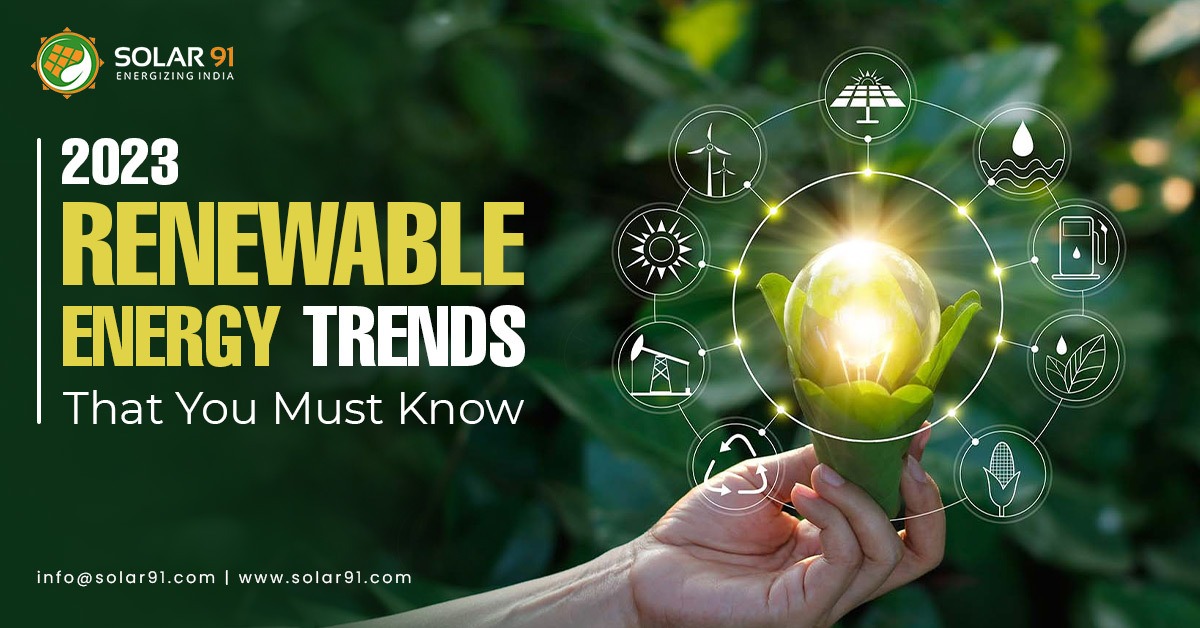2023 Renewable Energy Trends That You Must Know
Renewable energy sources like solar energy might potentially meet up to 65% of the world’s electricity needs by 2030 at a cost-effective level. This could dramatically reduce carbon emissions and help to mitigate climate change by 2050, cutting the power sector’s carbon emissions by 90%. The International Energy Agency predicted in research released in November 2019 that by 2024, about 33% of the world’s electricity might come from renewable sources. There are several reasons to be optimistic about the future of renewable energy in 2023 as of right now.
Growth metrics are anticipated to increase in 2023 due to demand and the significant increase in renewable energy. Electricity produced from renewable sources is becoming more affordable quickly. By immediately converting to renewable energy sources, many businesses might save money and protect the environment. It raises the question of what changes and fads we can expect to witness in 2023.
A Significantly Wider Use of Artificial Intelligence
One of the most intriguing recent discoveries is the growing significance of AI in the solar energy sector. In spite of all the hoopla, artificial intelligence is still underused to a great extent. However, things could swiftly alter, possibly as early as 2023.
Numerous uses of artificial intelligence, such as the effective optimization and integration of variable renewable energy sources into the power grid, could hasten the global transition to a cleaner source of energy. These uses of AI may accelerate the transition in the solar energy sector.
Increased Adoption of Energy Storage Technologies
Energy storage is necessary to maintain an equilibrium between the supply and demand for renewable energy. Battery storage system use has accelerated as a result of the global switch to renewable energy sources. Systems for both long- and short-term battery storage will be essential in 2023 and the years that follow.
The requirement for battery storage is directly impacted by the increase in electric vehicles on the road. By 2050, there should be over 836 million EVs on the road, up from the present estimate of 16.5 million. There have been significant quality improvements and general cost reductions in energy storage. So in 2023, expect to see additional improvements and adoption of energy storage technologies.
Large-scale solar farm expansion
As more nations expand their investment in renewable energy, it is anticipated that large-scale solar farm expansion will continue in 2023. As a scalable and affordable source of renewable energy, solar farms may lessen dependency on fossil fuels and increase energy security.
Expansion of rooftop solar panel installations
In 2023, rooftop solar panel installations are predicted to increase, especially as more homes and businesses seek to cut their energy expenses and lessen their environmental impact. Rooftop solar panels can be an affordable source of clean energy and can lessen reliance on the power grid.
Adoption of energy storage technologies
By 2023, batteries and other energy storage technologies should be used more frequently. Energy security may be increased, grid dependence will be reduced, and renewable energy sources can be used more efficiently thanks to energy storage systems.
Expansion of off-grid solar
In 2023, off-grid solar, which provides electricity to people and communities not linked to the grid, is anticipated to keep expanding. Off-grid solar can boost economic growth and development by bringing electricity to isolated or rural locations.
The adaptation of smart grid technologies
In 2023, it’s anticipated that the smart grid technology, which enables the efficient operation of energy supply and demand, will be used more widely. Energy waste can be decreased and renewable energy sources can be more effectively integrated into the grid thanks to smart grid technology.
Key Drivers for Energy Transition
It is obvious that there is a push to move away from fossil fuels. Greater electrification and energy efficiency will continue to be key energy industry trends in 2023. Three main forces are at work.
Fossil fuels’ high costs and the effects they have on the environment
The price of fossil fuels is rising due to the Ukraine War, OPEC Production Policies, and US Government Energy Policies. Some segments of the public place protect the environment above other concerns, and governments are suddenly concerned about energy dependence and energy concerns.
Electrifications
The idea of driving is changing as a result of electric vehicles and battery technology. Legislation to gradually phase out the production of cars with gasoline engines is already being written in several countries. Manufacturing may adopt similar energy trends in 2023, particularly if there is a disruption in the natural gas supply.
Energy Savings
The public’s desire for energy efficiency is rising as a result of increased living expenses and difficult economic situations. Consumers are less tolerant of wasteful methods and inadequate infrastructures that increase the cost of manufactured goods and household energy bills.
Conclusion
We have the vision to use clean, inexpensive, and sustainable energy sources to contribute to the development of a better world despite the immense hurdles associated with making a global transition toward sustainable energy sources. The company has integrated sustainability into its own operational and production processes and implemented energy-efficient circular economies inside its own operations.

